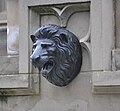Gutenberg Monument (Frankfurt am Main)
The Johannes Gutenberg Monument is a memorial and fountain on the Roßmarkt in Frankfurt am Main . It is reminiscent of the inventor of book printing with movable metal letters, Johannes Gensfleisch , known as Gutenberg, as well as the printers and publishers Johannes Fust and Peter Schöffer who worked with him in Frankfurt .
history
The Johannes Gutenberg monument is on the Roßmarkt in Frankfurt am Main . It is the work of sculptor Eduard Schmidt von der Launitz (1797-1869) on the occasion of the fourth centenary of the invention of printing with movable metal - letters the statues of three Frankfurt printer in terracotta Customized and on June 24, 1840 presented to the public. He was commissioned by the then Frankfurt Monument Committee.
During the four-centenary of that time, the printers of the Vormärz marched through the city saying: “You gave your work to the people as a weapon, so that they may create justice and freedom!” Eight years later, the March Revolution of 1848 came.
1440 poured Johannes Gutenberg pilgrimage mirror ( convex mirror ) for the pilgrimage to Aachen with which the pilgrims at the Zeigungen the relics something of the blessings bill could take to capture the relics and home. It appears from the case files in this connection that he bought lead and a printing press in connection with this .
Gutenberg lived in Frankfurt from 1454 to probably 1457. Here he printed the indulgence letter , the Turkish calendar and the crusade bull of Pope Calixt III.
The actual monument was only created between 1856 and 1858 and inaugurated on October 20, 1858. It replaced a Hercules fountain that stood in the same place at the time. The basis for the memorial were the three terracotta statues by the sculptor Eduard Schmidt von der Launitz from 1840. These were first made as plaster copies by the artist Georg Ludwig von Kreß and later using the technique of the Frankfurt physicist Rudolf Christian Böttger Electroplating provided with a bronze coating. The plaster copies could be viewed by the public for a fee . The construction of the monument was financed with the fee. The pedestal and base of the monument are made of sandstone .
The monument is a listed building .
description
The three figures of Johannes Gutenberg , Johannes Fust and Peter Schöffer stand on a square pedestal .
The cornice below the capital of the pedestal has fourteen heads showing portraits of printers and publishers from different centuries, as well as the creator of the monument, the sculptor Eduard Schmidt von der Launitz . The other portrayed are Will Caxton , Aldus Manutius , Estienne , Hans Luft , Johann Egenolf, Elzevir , Feierabend , Breitkopf , Bodoni , Didot , Tauchnitz , Brönner , Andreae and König .
The four walls of the pedestal are adorned by the four coats of arms and coat of arms holders of the three places of activity, Mainz , Frankfurt and Strasbourg , which are connected with Gutenberg, as well as the printing city of Venice, an important printing site of the Renaissance and Baroque periods .
There are four allegories on the four galleries on the plinth below the pedestal . The allegory of science ( Latin scientia = knowledge), industry ( Latin industria = diligence), poetry and theology .
Below the four allegories there are four gargoyles in the form of four animal heads, which are supposed to represent the four continents . The bull stands for Europe , the lion for Africa , the elephant for Asia and the lama for America . The four animal heads feed four well basins in the warmer season.
gallery
- Panorama, statues and inscription
Gutenberg Monument before 1892
Photograph by John Lawson Stoddard
- Coats of arms of the printing cities
- Allegories
- Animal heads as gargoyles
See also
Web links
Individual evidence
- ↑ a b c d e f Wilfried Ehrlich: Frankfurter Brunnen. (PDF) Building Department of the City of Frankfurt, pages 13-14, December 1985, accessed on February 7, 2015 .
- ↑ a b Gutenberg Memorial. Art in Public Space Frankfurt, accessed on February 8, 2015 .
- ↑ Heinz Schomann, Volker Rödel, Heike Kaiser: Monument topography city of Frankfurt am Main. Revised 2nd edition, limited special edition on the occasion of the 1200th anniversary of the city of Frankfurt am Main. Societäts-Verlag, Frankfurt am Main 1994, ISBN 3-7973-0576-1 , page 68
- ↑ Egenolf, Johann Augustin Deutsche Biographie, accessed on July 3, 2018.
Coordinates: 50 ° 6 ′ 44.3 " N , 8 ° 40 ′ 35.2" E
















